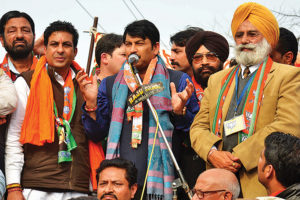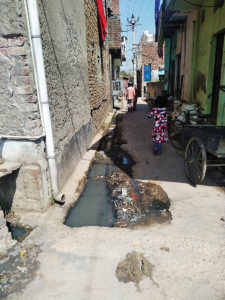Manoj Tiwari adopted Kadipur village in North East Delhi to be a model for development. In 2017, it became Delhi’s first free wi-fi village. But basic struggles continue to plague the area
In one corner of North East Delhi, far from any metro station or bus route, lies the small village known as Kadipur. Delhi’s citizens might not have heard its name, but this is no ordinary village.
Under the central government’s Saansad Adarsh Gram Yojana, wherein all MP’s can adopt a village from their constituency as a model for development in other areas of the constituency, MP from North East Delhi and Delhi BJP chief Manoj Tiwari adopted this village, 8 km from Samaypur Badli metro station.

In all of his speeches, Manoj Tiwari takes pride in the work he has done for his adopted village, emphasizing that it is a model for the rest of the constituency. Patriot visited this village and found out if the residents of Delhi’s first free wi-fi village are satisfied with the work being done there.
“Wi-fi se kya hoga sir, yaha, pe toh paani hi nahi aata” (What’s the use of wi-fi when there is no proper water supply in the village) says Madan Lal, a 68-year old man who runs a grocery shop in the village. “Every morning a tanker comes and the whole village lines up to fight for buckets of water,” he says.
One can see innumerable taps and tubewells installed at the side of the road, but Madan says they remain non-functional most of the time. Echoing his words, Amba Devi, another resident of Kadipur says, “Sometimes, over 2-3 days at a stretch, that there is absolutely no water in the taps and wells. We have to wait for the water tankers,” she says. In fact, there are heaps of buckets in front of every house, which the locals use to fill up water from the tankers.

“Every day, I have to get up at 5 am and go downstairs to fill the water from the tankers,”says Ashish (name changed) a second year student in Zakir Hussain College, Delhi University. “I do not get enough sleep, and it hampers my studies,” he adds.
The first-time voter also adds that another major problem is that the area seriously lacks means of transport, cut off as it is from the rest of the city. “I have to walk 3-4 km daily to go the nearest auto stand, and from there the auto takes around Rs 70-80 to go to the Samaypur Badli metro station,” he says. “It takes me around 2-3 hours every day to reach college. I am thinking of shifting to a PG near the college, as commuting is really a hassle for me.
He, however, is pretty much satisfied with the wi-fi facility here. “I can now download study material sitting at home, that too free of cost,” he says. However, he too echoes the sentiments of others in the settlement about basic necessities. “Water and transport facilities should be given priority.”
“A bus used to ply in the area. But since the last year that too has stopped, and now there is nothing,” says Nutan (name changed), 22, who runs her own knitting school in the village. “Earlier a lot of students used to come here from neighbouring areas by boarding the bus — now only students of this area come to me,” she says regretfully.
“Also, there is not a single street light here, and at night it becomes extremely risky for women,” she adds. When enquired about how she feels about the free wi-fi, she replies “Woh toh sirf ameer logon ke liye hai.”
Another issue that plagues is the area is open drains. “This place is a breeding ground for mosquitoes. Every year there are several cases of dengue and malaria,” says Madan pointing to the open drain in front of his shop. Literally every alley of the village has an open drain, which connects to the large filth- filled canal at the entrance of the village. “The area literally stinks,” says Madan. During the rainy season, the area becomes waterlogged
Many residents, in fact, are not even aware of the fact that their MP has adopted this village. “We have hardly seen him here, on the roads, in the last couple of years. What we know is when he comes here, he does so to meet his friend Sudhir Rana,” says Madan. The political honcho of the area, Sudhir Rana is the former municipal councilor of Kadipur. Currently, his daughter Urmila Rana holds the post.
Some residents do have a good word for the work done here. Amit, 34, says, “Earlier the roads used to be filled with potholes, and always filled with water and mud. But since Tiwari ji adopted this village, he started working on the road and now you can see for yourself, how smooth it has become,” he says.
However, the fact is that the Nangli Ibrahimpur road which passes through Kadipur village was renovated under the orders of MLA of the Burari Assembly constituency, AAP’s Sanjeev Jha. However, Urmila Rana attributed this to Manoj Tiwari in several speeches.
Kadipur is being described as a ‘smart’ village and a ‘model’ village, while basic necessities like water and hygiene remain a primary issue for the villagers. Will the resentment reflect in the poll results?





